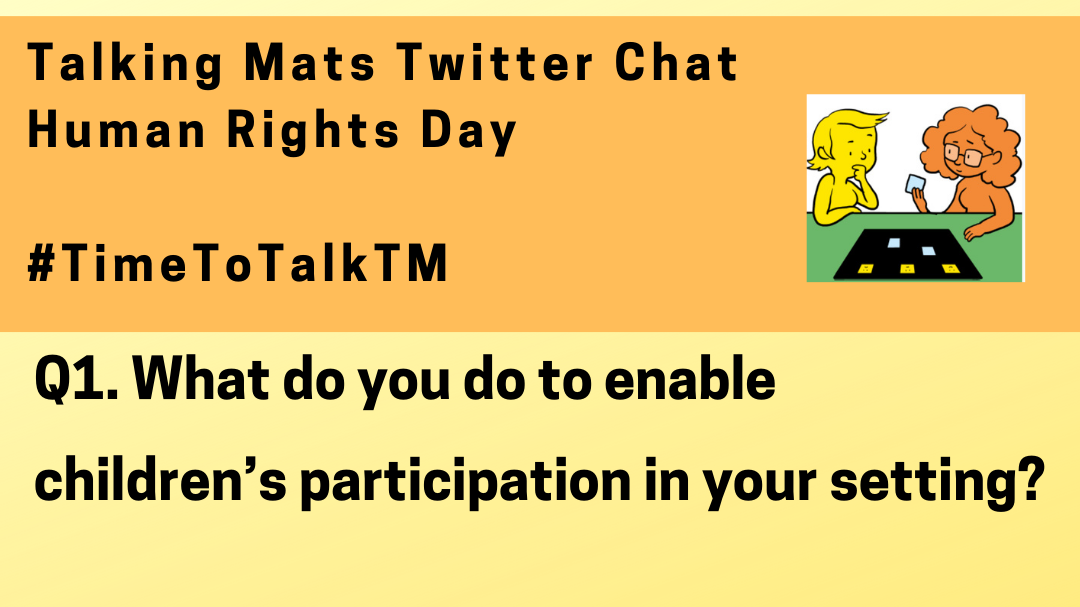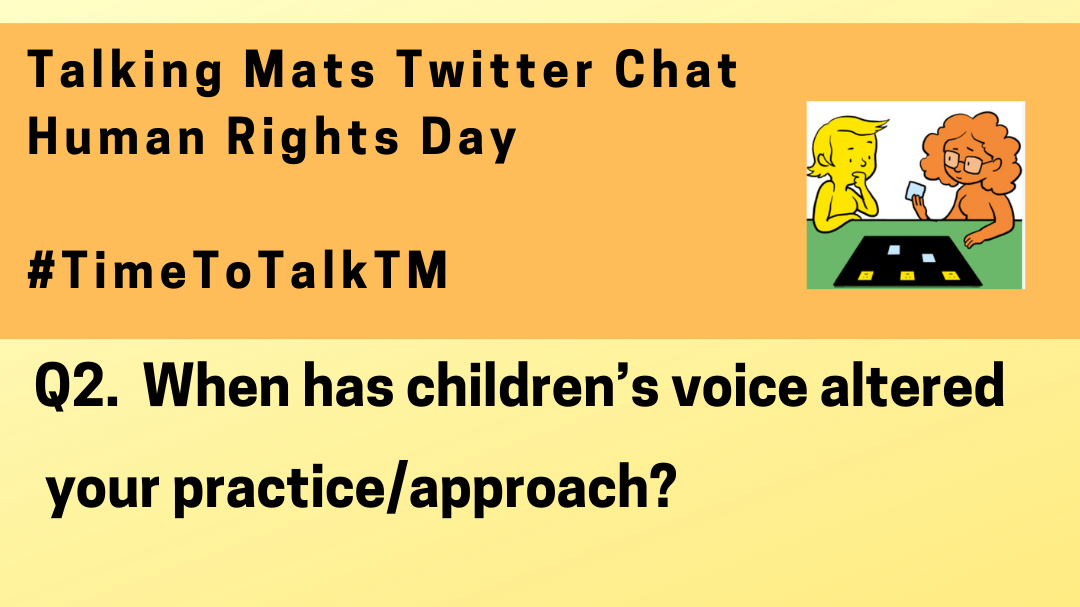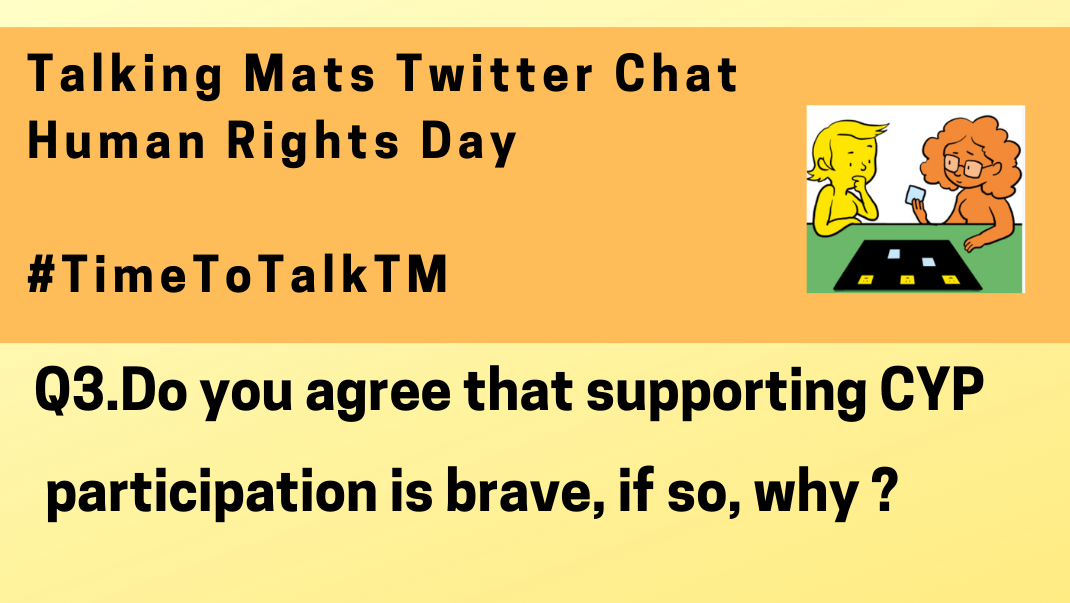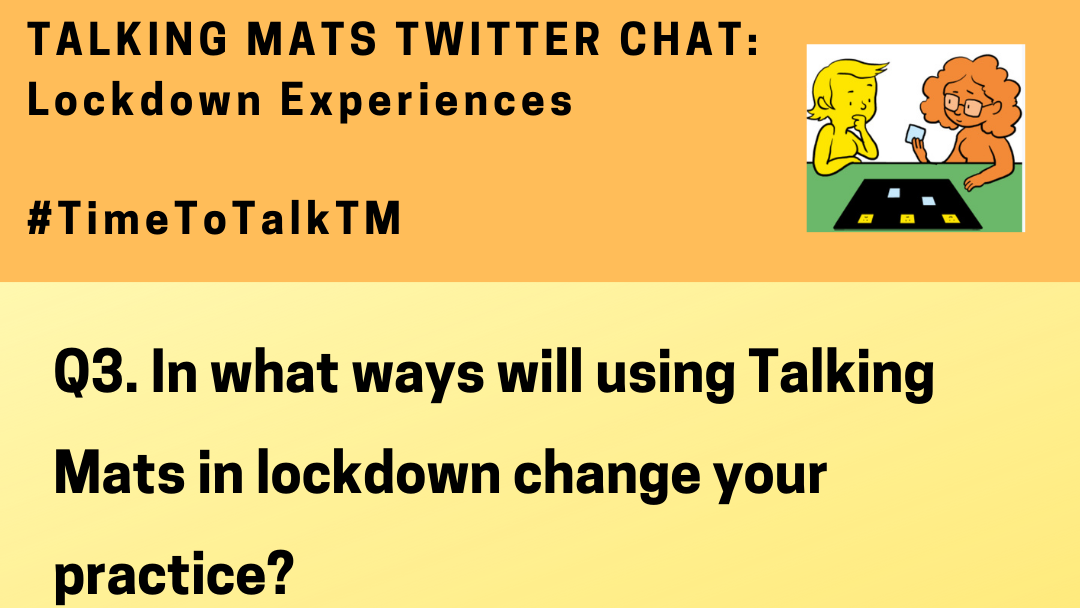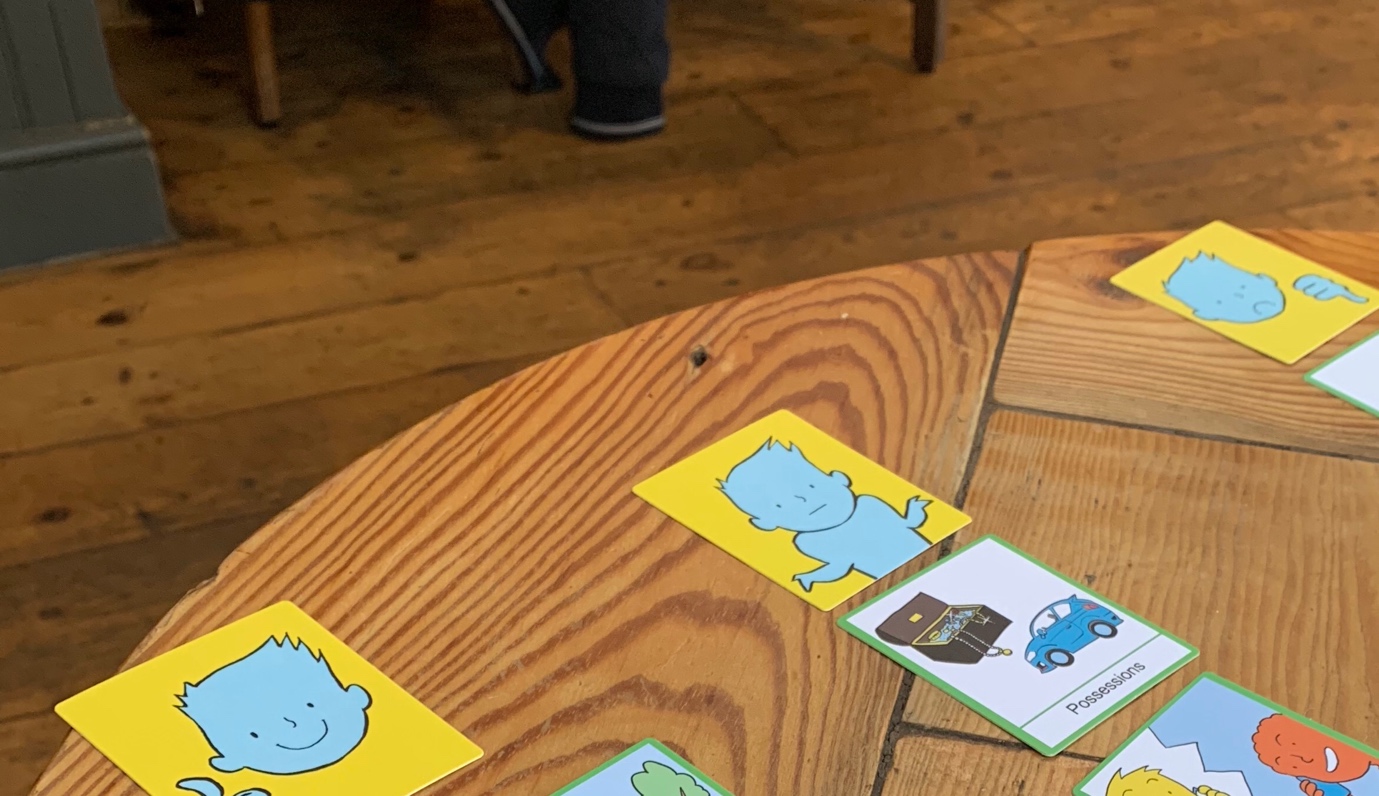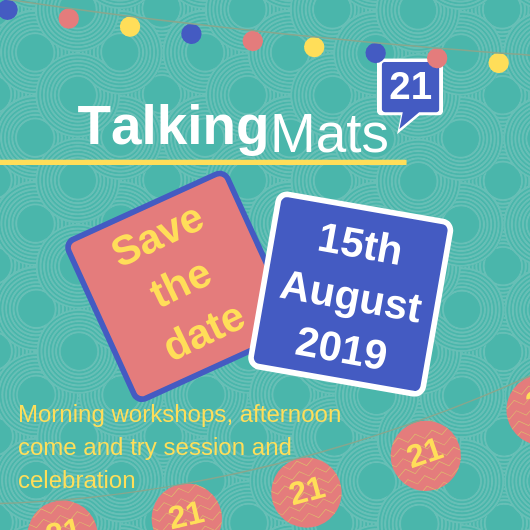This year, we wanted to give you plenty of notice of our upcoming January 2024 sale!
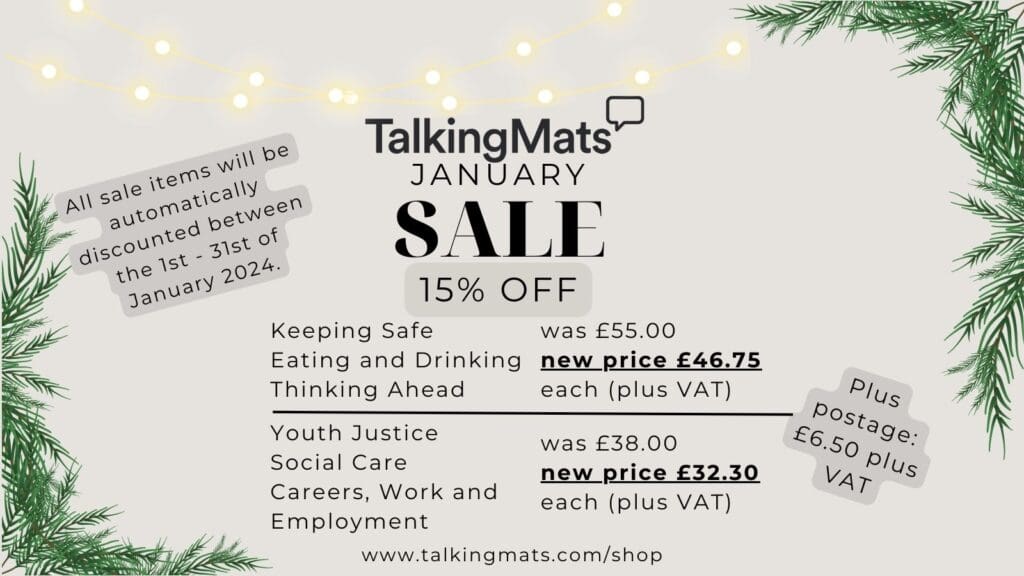
You can expect 15% off selected resources from the 1st -31st January 2024. These include:
Advanced Resources:
- Eating and Drinking
- Thinking Ahead
- Keeping Safe
which were £55.00 each and now £46.75 each plus postage and VAT.
Post Training Resources:
- Youth Justice
- Social Care
- Careers, Work and Employment
were £38.00 each now £32.30 each plus postage and VAT.

We also have 50% off Leisure Conversation Sets.
- Leisure Subset: Sport was £38.00 plus postage now £19.00 plus postage and VAT.
- Leisure Subset: Out & About was £38.00 plus postage now £19.00 plus postage and VAT.
All sale items will be automatically discounted between the 1st – 31st of January 2024.
Visit www.talkingmats.com/shop.
Merry Christmas and a Happy New Year from the Talking Mats Team!
Postage starts from £6.50 (plus VAT). All orders must be placed before the 31st of January 2024.
For organisations paying by Purchase Order, payment must be received within 28 days of the date that the order is placed for price to be guaranteed. Please make sure to include the £6.50 (plus VAT) postage cost on your purchase order document. If you require a quote for the purchase order, please email finance@talkingmats.com.
Communication is a fundamental human right, yet many individuals with communication difficulties face daily challenges in expressing their thoughts, needs and feelings. Augmentative and Alternative Communication (AAC) is a powerful tool that bridges this communication gap, and Talking Mats is one innovative approach that has proven highly effective in enhancing the lives of those who use AAC.
However, in the 25 years that Talking Mats has been developing resources we have never created one that specifically addresses the needs of AAC users.
Until now!
The new resource, Supporting Communication with AAC and the online advanced training module, AAC will be launched at this year’s Communication Matters Conference 9th-11th September.
The idea
Ace Centre first contacted us in 2018 with the idea of developing a specific assessment resource that would allow the person considering using AAC to express their views about it; were they ready to use AAC, did it fit with their life and communication needs and how much support would be required? This could then inform decisions around referrals onto specialist AAC services.
Development
As with all Talking Mats resources, this one was piloted and discussed and changed until the final version was reached. Thank you to all the practitioners and clients who gave their time and energy in that process. Thank you also to the Scottish Centre of Technology for the Communication Impaired who also collaborated on the resource and the module.
Outcome
The outcome is a resource that can contribute to both assessments and reviews, and an Advanced online training module, both of which aim to put the AAC user at the heart of decision making about their communication.
Here is a brief outline of the resource and the module.
Supporting Communication with AAC (card and digital resource)
Topics
Your Communication

This topic considers the ‘How’, ‘Who’ and ‘Where’ of interactions and helps develop an understanding of the Thinkers communication needs. It can be completed when you are getting to know the Thinker.
Joining in conversations

These topics are designed to help a Thinker explore how they feel about their AAC resource when it comes to joining in conversations and reflect the fact that an individual often uses a combination of communication modes to be effective. The three topic cards are: Verbal conversation, Paper support and Electronic Support.
How your AAC works
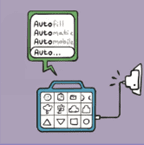
This topics explores different ways of accessing the AAC device as well as the different features it has, incluing functions, appearance, sound, and access.
If you are trained in Talking Mats to Foundation level you can buy the resource from our website
AAC Advanced module
To access this course you must have already completed the Foundation Course.
The objective of this course is to ensure that AAC users are at the heart of decision making and that necessary adaptations are in place to support those conversations
The course is split into three different sections:
The Resource
Aim – to recognise the different topics and who they might be suitable for
Access
Aim – to recognise different positions, places and methods for a Thinker to access a Talking Mat
Communication Dynamics
Aim – to recognise the dynamics in a conversation, and appraise the process of using additional people during a Talking Mat
To successfully complete the course participants must pass the quiz and contribute to the forum telling us about their experience.
Courses will run from the 1st of every month starting in November.
After many months of work the new Talking Mats sensory resource; Me and My Senses is reaching the final phase and registrations open on Friday 31st March for our launch seminar. This blog gives an overview of what’s in the resource and our guest blog to be published on Friday is a powerful story of professional and personal learning with ‘Me and my senses’ playing a pivotal role.
The resource will aim to enable children and young people who have speech, language and communication needs (SLCN) and sensory integration difficulties to have a voice in their therapy assessment, planning and intervention. To find out more about the funding and development for this project please read the earlier blog here. It is also aimed at supporting all practitioners, regardless of their level of sensory integration training, to gain an individual’s voice of their ‘lived’ sensory experiences, needs and challenges.
It is divided into the following topics:
- My Spaces & Things I Do
- My Senses 1: Proprioception & Interoception
- My Senses 2: Vestibular
- My Senses 3: Taste, Smell, Hearing, Seeing, Touch
Use of the resource may contribute to sensory integration evaluation but does not replace a full sensory integration assessment, however it may equally work as a stand alone-tool. We hope that professionals from healthcare,education, in both mainstream and specialist settings, as well as colleagues in social care will value this resource.
Talking Mats is hosting an online seminar to introduce the resource and we have 50 sets to give away for free to the first 50 people who register for the seminar and are already Talking Mats trained. Registrations open on Friday.
On Wednesday November 10th we held a colloquium with the University of Edinburgh and NHS fife to report on the findings of the research that was funded with the Burdett foundation . The easy-read version of this report can be found here.
48 people attended the online event on Wednesday and engaged in some very thoughtful discussion and reflection on communication in forensic settings. There was much to think about including whether ethos and values align with self-determination , how to get communication taken seriously by staff who are often under huge pressure. Consideration of where power lies in an organisation and an acknowledgment that in order to share power staff themselves need to feel they have power.
The recognition that in the promotion of shared decision making, you increase the risk of people taking what others may see as unwise decisions. The need to support the capacity of people to be involved in decision making early on and in the smaller decisions of life and not leaving including them to a crisis.
The importance of further research in his area and that small clinically driven research projects have an important role to play in addition to ones funded by bigger grants. There is much to digest and we are hoping to keep the conversation going.
If you would like to see for yourself the research presented and the topics discussed at the colloquium you can watch the recording of the Zoom session here.
If you want to attend foundation Talking Mats training please find out more here. if you have completed your foundation training please consider attending the Keeping Safe advanced online module which includes the Keeping Safe resource . If you have the Keeping Safe resource please download the new Being Included bolt on to use with it.
We are looking forward to our second Talking Mats Twitter chat on Thursday 10/12/20 7.30 – 8.30pm.
Join us to discuss and celebrate our new report ‘Can Scotland Be Brave’, which has a specific focus on children and young people’s participation. Find out more about the report here https://www.talkingmats.com/new-report-to-launch-10th-dec/
The report will be launched by the Scottish Government on the same day, to coincide with Human Rights Day 2020.
Here are the questions we will be asking:
Grab a cuppa – or better still, a mulled wine and mince pie! – and join us to share experiences and ideas.
Remember to use the hashtag #TimeToTalkTM on all your posts!
We are really looking forward to our first ever Talking Mats Twitter Chat on Thursday 01.10.20 from 7.30 – 8.30pm!
It will be a great opportunity to share experiences and ideas – here are the questions we will be asking:
This will be followed by a brief summary of the key learning points from the discussion. Join in and remember to use #TimeToTalkTM in all your comments – we look forward to chatting with you all!
Thanks to everyone who joined our second Zoom session on using Talking Mats remotely. The notes from the first session can be found here. It was great to share experiences and to welcome our international Talking Mats’ community too. We were impressed by your ingenuity and creativity in making TMs work remotely and there were lots of great stories of the use of it in practice. Here is a summary of the main points, with special thanks to Sam Quinn for explaining how to use 2 devices in order to see the person as well as the Mat.
Using a second device on a virtual Talking Mat session can help you to capture the thinker’s reaction to the mat and symbols. This can be particularly useful for recording videos to watch again later (obviously with the appropriate video consent). To do this on a tablet or mobile device and assuming you have already set up the meeting:
1. Open the Talking Mat app on your first device and prepare the symbol set you would like to use. When you are finished, minimise this app.
2. On the same device, open your communication app (Zoom, Microsoft Teams) and join your meeting.
3. Click ‘share’ and ‘screen’, then switch to the Talking Mats app. You should be able to control the Talking Mat while other people in the meeting can see it. It is advised you mute your volume to avoid interference.
4. On your second device (this could be a laptop, tablet or mobile) use the meeting ID that you sent to yourself to join the Zoom meeting.
5. On your second device, there is an option to split the screen so you can see both the thinker and the Talking Mat at the same time.
6. If you are using a PC or laptop as your second device there may be an option to record the session if you wish to do so.
Device one (tablet or mobile) hosts the Zoom/Teams meeting and is used to control the Talking Mat.
Device two (tablet, mobile or PC) acts as a second guest in the meeting and allows you to view the Mat and the thinker at the same time and record the session.
You can invite another device using Near Me/Attend Anywhere.
Remember you can still use the physical resources by holding the Mat to the camera and asking the thinker to tell you where to place the option on the Mat. Some have done this successfully.
You can try iPad mirroring https://tactustherapy.com/telepractice-how-to-mirror-apps-computer/ You can download a guide for how to do this if you follow the link.
A couple of people reported setting up Talking Mats by using https://miro.com/ and https://jamboard.google.com/ but, word of warning, it takes time to do this.
Remember you can use your digital login for the app (from Apple Store) and through the web browser http://www.digitaltalkingmats.com/ – make sure you enable FLASH.
And finally just to remind you that you can currently get a discount on the Digital Talking Mats resource:
DISCOUNTED DIGITAL TALKING MATS REQUEST FORM
Our online Foundation training is taking place throughout the year. Forthcoming courses are starting on 22nd September, 6th October and 3rd November. Reserve your place here.
If this is all new to you and you want to find out more about it, please listen to a webinar arranged by the Health and Social Care Alliance where Margo and Lois talk about Digital Talking Mats and how it can support wellbeing: https://www.youtube.com/watch?v=84CY3QFFa_g
Talking Mats as a Thinking Tool
In the first of a series of blogs showcasing some of the fantastic presentations delivered during our Talking Mats is 21 event on 15th August 2019, our OT Associate Rachel Woolcomb shares her thoughts on thinking – and how Talking Mats can help:
Recently I have been giving some thought to the process of thinking!
Is thinking just a matter of the neural pathways in our brains manipulating information about ourselves and the world, to create an output or action? or is it more than that?
Can we overthink? Is being spontaneous under thinking? What about creative thinking?
At the Talking Mats is 21 celebrations I explored this subject and looked at how Talking Mats can be used effectively as a tool to support thinking.
My presentation – Talking Mats as a Thinking Tool – looked at the mechanics of thinking, and started to explore how as humans we don’t just learn facts but begin to understand and make sense of them within the context of our culture and environment.
Thinking is effortful and depending on the subject we need to think about can be complicated and demanding.
Using a Talking Mat creates the space to think, it helps to reduce other distractions and provides a structure for thinking. This means that the process of thinking becomes energy efficient as a Talking Mat enables the thinker to organise their thoughts and make connections that otherwise might not be identified or explored. The images used in the topic sets help with memory recall and are designed to expand a subject. This reduces the reliance on language and the need to express what we are thinking verbally.
The Talking Mat forms a visual picture of our thinking which is helpful for reflection and further exploration of the subject.
The final few slides in my presentation contain some quotes from occupational therapists who have used Talking Mats within their supervision sessions to enable them to think about their coping skills and strategies whist at work. I will soon be sharing a resource document on the use of Talking Mats as a reflective space for clinicians.
For further details about our Talking Mats is 21 event and presentations check out our recent blog – https://www.talkingmats.com/amazing-talking-mats-is-21-day/
If you are interested in accessing Talking Mats training, follow this link for more details of the options we can offer – https://www.talkingmats.com/training/
Watch this space for more information from the presentations delivered at our #TMis21 Event!
Rachel Woolcomb, our Talking Mats OT Associate, shares a recent personal experience where she used Talking Mats to support a difficult conversation:
The vision of Talking Mats is to improve the lives of people with communications difficulties. I have been reflecting recently on the definition of ‘communication difficulties.’
When I first heard about, and started to use Talking Mats 10 years ago, my perception was that it was fantastic for those that could not speak but I must admit I didn’t really consider using it with people who, such as myself, could use their voice to communicate.
Over the years as my understanding has developed, and I have looked further into the use of Talking Mats as a ‘thinking tool’ I have come to a different conclusion.
I would like to suggest that at some points in our lives, each one of us is likely to experience a communication difficulty. I don’t mean that we cannot physically speak, but that we cannot express what we really want to say in words. Perhaps a topic is too difficult to talk about with someone so we don’t bother, or we are overwhelmed by the subject that we don’t really know where to start.
One such subject is that of death and dying.
We know it will happen to us all one day but to talk openly with loved ones, is for some reason, too much to comprehend, too emotive, or considered bleak.
I am very fortunate enough to have grandparents in their 90’s however the conversation about their wishes for the future goes unspoken. It is a challenge for my parents to raise the issue therefore it remains the big unknown.
This is a common problem. In 2009, The National Council for Palliative Care wanted to address this issue and set up the Dying Matters Coalition in England and Wales, to help people talk more openly about dying, death and bereavement and to make plans for the end of life.
Talking Mats have produced a set of topic cards called ‘Thinking Ahead.’ https://www.talkingmats.com/product/thinking-ahead/
These were created in consultation with Strathcarron hospice to help people with advanced illness or long term conditions to think ahead and plan for the future. The three topics in the set are: Affairs, Care and Treatment and Personal Values.
My Mum was interested in my role with Talking Mats and wanted to understand what it was all about. We had already started to talk about the challenges of having difficult conversations, especially about death, and therefore over a drink, in a relaxed coffee shop, we embarked on a journey of discovery using a Talking Mat. My Mum as the Thinker and myself as the Listener .
She used the Talking Mat to help her think about things she had not considered and was able to make plans about what she wanted to do next. I heard her wishes and her thoughts, on why certain things were important to her. It was a very special time, facilitated by a Talking Mat.
My challenge to you as readers of this blog is to ask yourself ‘what do I have difficulty talking about’ – A Talking Mat just might be the answer!
Another resource you might find helpful is ‘Let’s Talk about Death and Dying’ – www.ageuk.org.uk
Rachel will be running a ‘Talking Mats as a Thinking Tool’ workshop at our Talking Mats is 21 Event is in Stirling on Thursday 15th August 2019. Dr Sally Boa from Strathcarron Hospice will also be running a ‘Talking Mats in End of Life Care’ workshop at this event. Thanks to funding from NHS Forth Valley endowment committee the event is free but you do need to book your space https://www.eventbrite.co.uk/e/talking-mats-is-21-tickets-62362171935
You can come to the morning only, afternoon only or come for the whole day.
If you can’t come to our event watch out for out blogs and social media celebrating the reach of Talking Mats for 21 days before the 15th of August. Please join in with your contributions using the hashtag #TMis21. For 21 days after our event we will be having a special Birthday offer! Watch this space, more to follow …….
Last week, Laura Holmes, our NW England Associate, had the pleasure of interviewing our inspirational Founder, Joan Murphy. Joan will be retiring after our Talking Mats 21 event on 15th August 2019 and so this was a great opportunity to find out more about her Talking Mats experiences:
Are there any stand-out moments for you, from your Talking Mats time?
Talking Mats are now used in many countries across the world and it has been great to have the chance to travel widely. One particular moment which stands out for me was during one of two trips I made to China with Sally Boa. I was asked to demonstrate Talking Mats with a man who was in hospital having had a stroke. He had no speech and was using a wheelchair. I used Talking Mats to find out what the man felt he could/ couldn’t do. The man shared that he felt he could walk. I had to present the symbol three times as the family members and medical staff watching were adamant that the man could not walk. On the third time, the man pushed the table, moved his wheelchair back then stood up and walked around the room. His family and medical team were completely shocked and realised that no-one had actually thought to ask him if he could walk. This was a massive turning point both for the man – and also for his family and medical team, who could now see the power of using a Talking Mat.
Have you done any Talking Mats yourself that helped you to make an important decision for you or your family?
Absolutely – quite a few! My husband and I both used Talking Mats for our Power of Attorneys and shared them with our lawyer and grown-up children. My husband and I also used Talking Mats to talk about the Scottish Referendum as we had opposing views – it really helped as it made us listen to each other without interrupting. We then went on to use the mats as part of a presentation. Various members of my family have used mats to explore personal issues and decisions
What are the top tips you have gained from your Talking Mats journey – from working in the NHS and then more recently as a social enterprise?
You have to have humour. And be able to listen. It has been essential to be able to work in partnership with Lois and the other Talking Mats team members. The team are such nice people to work with and we have lots of laughs. Setting up as social enterprise was vital for Talking Mats – in terms of having the freedom to be creative. It felt as though someone had a big rubber band which was able to be released. It was a huge risk and there have been lots of leaps of faith along the way.
Do you have any top tips for people using Talking Mats in the Listener role?
Be quiet – and Listen! It’s also important to feel relaxed and to have a sense of humour whilst using it. A Talking Mat is not a test – it is serious, and can be used to explore difficult issues, but it should be fun.
Talking Mats is a low-tech AAC system – do you think it has a place in the modern world?
It is absolutely crucial! Low-tech resources are fundamental in terms of being able to have and develop conversation skills and social closeness.
What do you want for Talking Mats in the next 10 years?
World Domination! Talking Mats has the potential to be used everywhere in the world, by everyone. However I would like to see Talking Mats continue to have a small core team, but increasing Licensed Trainers across both the UK and the rest of the world.
Our Talking Mats is 21 Event is in Stirling on Thursday 15th August 2019. Thanks to funding from NHS Forth Valley endowment committee the event is free but you do need to book your space https://www.eventbrite.co.uk/e/talking-mats-is-21-tickets-62362171935
You can come to the morning only, afternoon only or come for the whole day.
If you can’t come to our event watch out for out blogs and social media celebrating the reach of Talking Mats for 21 days before the 15th of August. Please join in with your contributions using the hashtag #TMis21. For 21 days after our event we will be having a special Birthday offer! Watch this space, more to follow …….
 Online training login
Online training login 

